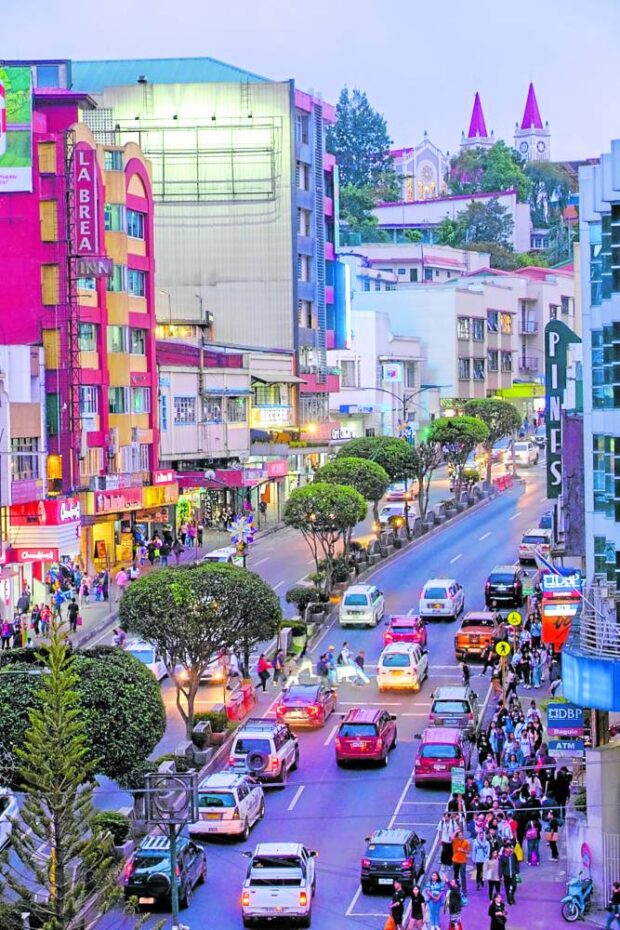
BAGUIO CITY, Benguet, Philippines — Before American President Theodore Roosevelt appointed him as his war secretary in 1908, Governor General of the Philippines Luke Edward Wright galloped on horseback up what everyone now knows as Session Road to convene the Second Philippine Commission here from April 22 to June 11 in 1904.
This colonial body formed the bureaucracy that governs the country today and spent part of that work in this upland territory that was later opened as the summer capital in 1909.
Inevitably, all roads soon led to the 1.7-kilometer Session Road, which is at the heart of downtown Baguio.
Next year, Session Road will undergo its next evolution as it will be redesigned to complement Baguio’s “living streets.”
A “living street” is an urban renewal concept that turns the common road into a shared space with amenities like roadside landscapes filled with trees, flowering plants and shrubs, park seats or benches, and “traffic calming” devices like bollards so cars would be forced to reduce speed and ensure the safety of pedestrians and cyclists.
Two side streets that branch off Session Road — Carantes Street, which is a stone’s throw away from century-old Burnham Park, and Jacinto Street beside Malcolm Square — are the first “living streets” being put up by the city.
These side roads were once dilapidated and unused sections of downtown Baguio, “so the city government is making these roads safe and convenient for people again,” said Richard Lardizabal, the government engineer who presented the Session Road plans at the city council’s budget hearing this week.These narrow streets have also been adorned with murals by local art groups.
A P120-million allocation in the 2024 city budget would convert Session Road itself from the current four vehicular lanes to five by removing a center island filled with small trees, according to plans discussed at the budget session.
The trees would be transplanted on the sidewalks which would be widened into 4- to 5-meter “green walkways.”
READ: Big-ticket road, transport systems eyed in Baguio
Wider sidewalks
The walkways would be composed of a “frontage zone,” or the display sections and entrances of shops and stores; an unobstructed walking zone; a “furnishing zone,” or a health and lifestyle space filled with street lamps and benches; and a green buffer zone which actually acts as a “bioretention space” to absorb or redirect rainwater runoff.
Session Road’s redevelopment was introduced at a public-private partnership summit organized early last month by Mayor Benjamin Magalong, where some of the country’s top developers outlined their solutions to Baguio’s urban problems, like traffic congestion.
Session Road has been the subject of a pedestrianization campaign that was launched as early as 2008 by the late architect and urban planner Joseph Alabanza. On Jan. 28, 2012, he was allowed to turn the main road into a purely pedestrian zone for nine hours as an experiment.
Since 2019, Magalong has been opening Session Road to pedestrians every Sunday and has used the main street as a weekend bazaar for business startups and micro and small enterprises shortly after quarantine restrictions imposed during the coronavirus pandemic began to ease.
He informed the council on Oct. 23 that Baguio was negotiating with the Department of Public Works and Highways for an exemption to the standard rule that the lane width of national roads must be 3.35 meters. The five-lane project would reduce Session Road lanes to 3.15 meters.
The primary goal of modernizing Session Road is to improve the level of services for pedestrians and cyclists, according to city officials, citing a 2018 Baguio pedestrian flow study conducted by the Saint Louis University (SLU) School of Engineering and Architecture.
A modern Session Road is also part of an initiative to turn Baguio into a smart (or fully automated) city.
For instance, the Session Road plan includes the installation of waiting sheds in strategic corners of the main street that would have AI-aided amenities such as smart boards that provide maps and directions to visitors and commuters.
READ: Baguio council objects to BCDA extension bill
Modernity, history
The conceptual design for the new Session Road reserves the 3.5-meter-wide center lane for a future tramline, one of several environment-friendly mass transport options being eyed by Magalong, said architect Donna Rillera-Tabangin, the city planning officer.
Once completed, the center lane would temporarily serve as a dedicated mass transport lane for jeepneys, mini-buses and taxicabs, and as an emergency lane for fire trucks and ambulances, she told the council.
SLU designed uniform smart signage for Session Road establishments to take the place of conventional signs that clutter the historic street. Instead, each building would bear QR codes that allow people to view its history, a directory of offices and shops it hosts, and a menu of services available in its various establishments.
The university also curated new color palettes for its buildings to highlight Baguio’s history, being the only Filipino city built from the ground up by the American colonial government, as well as the country’s first creative city under the network of the United Nations Educational, Scientific and Cultural Organization in 2017.
A special feature of Session Road that is being developed by the University of the Cordilleras taps “augmented reality” or holograms so the city government can show short movies or clips of Cordillera performances on Session Road building walls to showcase Baguio’s indigenous Filipino roots.